Table Manners And First Code Of Correct Behavior Were Introduced In Egypt 2,500 B.C. By Ptahhotep
Ellen Lloyd - AncientPages.com - Louis XIV, known as Louis the Great or the Sun King (1638 – 1715), couldn’t stand bad table manners. The Sun King is today remembered as a royal who preferred art over politics. He was also a king who introduced complicated rules for doing anything, including dining.
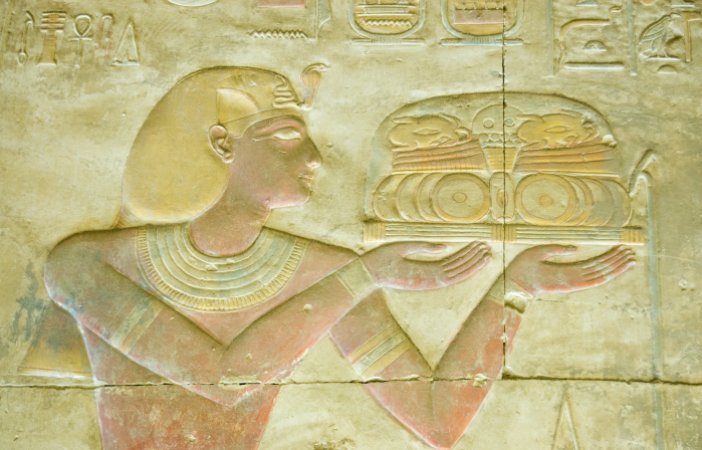
Ancient Egyptians were familiar with table manners in 2,500 B.C. Credit: BasPhoto - Adobe Stock
Around 1669, King Louis the Great became the “first person in Europe to offer his guests a place setting with knives, forks, and spoons; he ordered the knives should have rounded ends to prevent injury should things turn ugly.” 1
Forks were still a new trend, and many were reluctant to use forks. “When the first forks appeared, they caused a sensation, but getting people to use them for eating was not easy. Not only were forks very expensive, but they were also disapproved by the Church, and people did not know how to use them.” 2
The Church argued God had created humans with fingers so they could touch and eat God’s food. People may have listened to the Church, but obviously, they didn’t pay much attention to these warnings. The Church’s disapproval did not stop people from producing gold and silver forks that wealthy families in Tuscany wanted to have at the dining table.
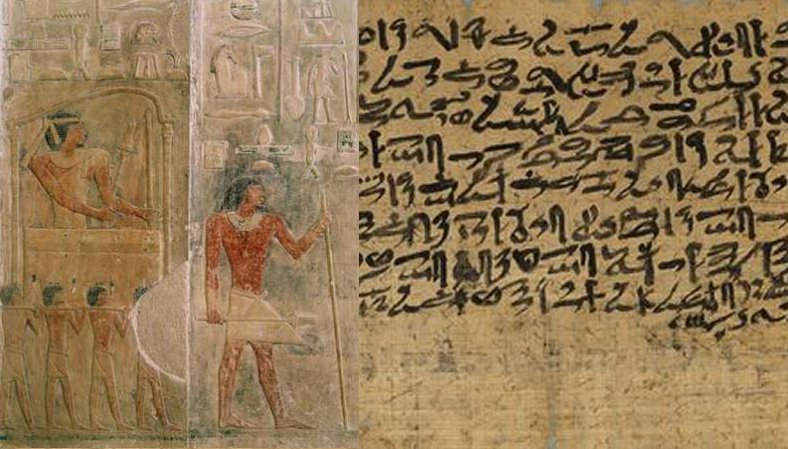
Left: Ptahhotep on a palanquin, relief from his tomb. Werner-Forman Archive/Heritage-Images - Right: The Maxims of Ptahhotep, Public Domain
Slowly, eating etiquette evolved in Europe. People washed their hands before dinner and stopped blowing their noses into their palms during the meal.
One would think table manners were introduced in Europe, but that’s wrong. Europeans suddenly felt they had “discovered” what should be considered proper manners at the table. However, these table manners and dining etiquette were introduced in Egypt in about 2,500 B.C.
“During the Fifth Dynasty (2,500 B.C. – 2,350 B.C.), Egyptian Vizier Ptahhotep, occasionally known as Ptahhotep I, Ptahhotpe or Ptah-Hotep, wrote several instructions based on his wisdom and experiences.
His precious text contains advice on how to live your life, and much of what he wrote is still highly relevant today.” 3
The first historical evidence of correct behavior can be traced to Ptahhotep’s book The Instructions of Ptahhotep.
Knowledge of our ancestors’ views of correct manners became evident with the discovery of the ancient Egyptian Prisse Papyrus. The text datable to the Middle Kingdom was found inside the coffin of Pharaoh Sekhemre-Wepmaat Intef of the 17th Dynasty at Thebes.
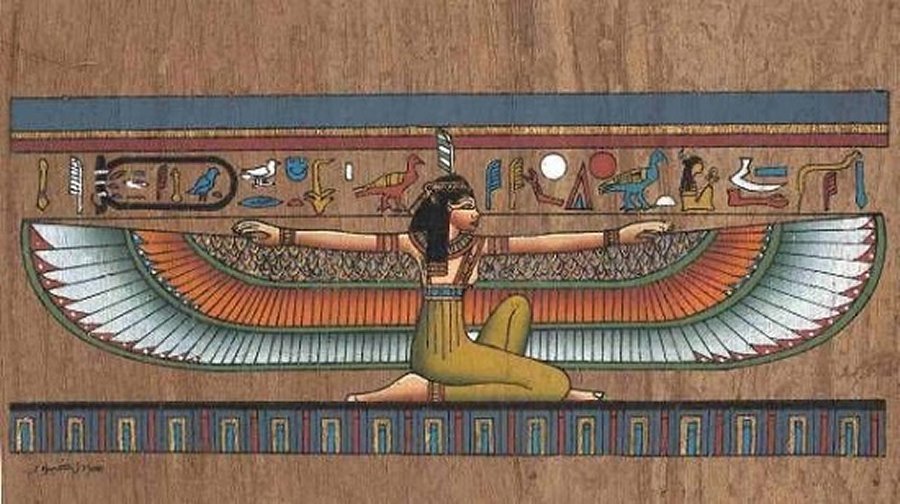
Maat - Ancient Egypt’s Most Important Religious Concept - Read more
The papyrus document contains the last two pages of the Instructions of Kagemni, followed by the only complete surviving copy of the Instructions of Ptahhotep.
The precious papyrus that predates the Bible by about 2,000 years now resides in the Paris antiquities collection.
One must admit that even from our modern perspective, it’s a fascinating ancient text that gives so much advice on behaving in ordinary situations.
“In the company of one’s superior, the book advises, “Laugh when he laughs.” It suggests overlooking one’s quiddities with a superior’s philosophy, “so thou shalt be very agreeable to his heart.” There are numerous references to the priceless wisdom of holding one’s tongue, first with a boss: “Let thy mind be deep and thy speech scanty,” then with a wife: “Be silent, for it is a better gift than flowers.” 4
Vizier Ptahhotep was, in many ways, a man ahead of his time. When the Bible was written, his 2,500-year-old advice had been well circulated throughout the Nile delta of Egypt and the fertile crescent of Mesopotamia. Scholars who have studied the Bible have discovered strong echoes of The Instructions Ptahhotep in the Holy Book. The Bible frequently mentions food in various contexts, and the vizier’s guidelines, especially in Proverbs, contain instructions on how to eat and prepare food.
To embrace the central concept of Egyptian wisdom, one must first understand the importance of the goddess Maat, which symbolizes cosmic order and social harmony.
Students of the Old Testament will find many themes reflecting Egyptian instructions written by Ptahhotep, who covered all topics, including table manners.
Updated on January 5, 2024
Written by Ellen Lloyd – AncientPages.com
Copyright © AncientPages.com All rights reserved. This material may not be published, broadcast, rewritten or redistributed in whole or part without the express written permission of AncientPages.com
Expand for references- Nicholas Clayton - A Butler's Guide to Table Manners
- Sutherland - Troublesome Ancient History Of Forks Started In Tuscany, Italy In 11th Century, AncientPages.com
- Ellen Lloyd - Secrets Of Maxims Of Ptahhotep – Ancient Egyptian Wisdom Is Still Relevant Today. AncientPages.com
- Panati, Charles - Extraordinary Origins of Everyday Things
- Fontaine, Carole R. "A Modern Look at Ancient Wisdom: The Instruction of Ptahhotep Revisited." The Biblical Archaeologist44, no. 3 (1981): 155-60. Accessed October 26, 2020. doi:10.2307/3209606.
More From Ancient Pages
-
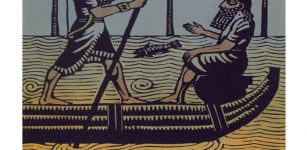 Missing Lines From Epic Of Gilgamesh Shed New Light On Humbaba
Artifacts | Oct 9, 2015
Missing Lines From Epic Of Gilgamesh Shed New Light On Humbaba
Artifacts | Oct 9, 2015 -
 Feared Skinwalker – Shapeshifter That Uses Mind Control To Hurt Victims In Native American Mythology
Featured Stories | May 16, 2019
Feared Skinwalker – Shapeshifter That Uses Mind Control To Hurt Victims In Native American Mythology
Featured Stories | May 16, 2019 -
 Gigantic Engravings Of A Giraffe Created Long Before Egypt As We Know It Existed
Civilizations | Jan 14, 2015
Gigantic Engravings Of A Giraffe Created Long Before Egypt As We Know It Existed
Civilizations | Jan 14, 2015 -
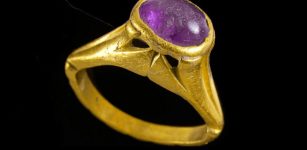 Ancient Greek Amethyst Ring To Ward Off A Hangover Discovered At The World’s Largest Byzantine Wine Factory In Yavne, Israel
Archaeology | Nov 12, 2021
Ancient Greek Amethyst Ring To Ward Off A Hangover Discovered At The World’s Largest Byzantine Wine Factory In Yavne, Israel
Archaeology | Nov 12, 2021 -
 On This Day In History: Julian ‘The Apostate’ Died During The Retreat From The Sassanian Empire – On June 26, 363
News | Jun 26, 2016
On This Day In History: Julian ‘The Apostate’ Died During The Retreat From The Sassanian Empire – On June 26, 363
News | Jun 26, 2016 -
 Vettuvan Koil Temple Spectacular Monolith Dedicated To Lord Shiva And Built By Pandya Dynasty
Featured Stories | May 25, 2021
Vettuvan Koil Temple Spectacular Monolith Dedicated To Lord Shiva And Built By Pandya Dynasty
Featured Stories | May 25, 2021 -
 İnkaya Cave Study Brings To Light 86,000-Year-Old Traces Of Human Life
Archaeology | Aug 22, 2023
İnkaya Cave Study Brings To Light 86,000-Year-Old Traces Of Human Life
Archaeology | Aug 22, 2023 -
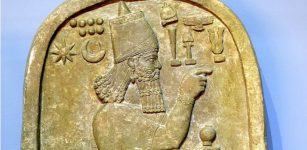 Stele Of Tell al-Rimah And Deeds Of Assyrian King Adad-nirari Against Rebellious Kings
Featured Stories | Feb 22, 2022
Stele Of Tell al-Rimah And Deeds Of Assyrian King Adad-nirari Against Rebellious Kings
Featured Stories | Feb 22, 2022 -
 The Brujo De Chiloé – The Wild Warlocks Of The Chiloé Archipelago
Featured Stories | May 4, 2022
The Brujo De Chiloé – The Wild Warlocks Of The Chiloé Archipelago
Featured Stories | May 4, 2022 -
 Major Underwater Archaeological Find On The Western Coast Of Sicily – Artifacts From The Battle Of The Egadi Islands?
Archaeology | Sep 11, 2023
Major Underwater Archaeological Find On The Western Coast Of Sicily – Artifacts From The Battle Of The Egadi Islands?
Archaeology | Sep 11, 2023 -
 Secret Ancient Knowledge Of Portals Leading To Unknown Realms – Mysteries Of The Past And Present – Part 2
Featured Stories | Dec 7, 2021
Secret Ancient Knowledge Of Portals Leading To Unknown Realms – Mysteries Of The Past And Present – Part 2
Featured Stories | Dec 7, 2021 -
 Neanderthals Buried Their Dead – New Evidence
Archaeology | Dec 10, 2020
Neanderthals Buried Their Dead – New Evidence
Archaeology | Dec 10, 2020 -
 Home Of The Gods – The Return Of The Gods – Part 3
Civilizations | Jun 14, 2018
Home Of The Gods – The Return Of The Gods – Part 3
Civilizations | Jun 14, 2018 -
 Vindelev Treasure – Surprising Evidence Of Nordic Connection With The European Iron Age Elite
Archaeology | Apr 9, 2024
Vindelev Treasure – Surprising Evidence Of Nordic Connection With The European Iron Age Elite
Archaeology | Apr 9, 2024 -
 Surprising Discovery In Valsgärde Viking Boat Graves – Scandinavian’s Oldest Down Bedding Found
Archaeology | Mar 27, 2021
Surprising Discovery In Valsgärde Viking Boat Graves – Scandinavian’s Oldest Down Bedding Found
Archaeology | Mar 27, 2021 -
 Medieval Mythbusting – New Research Rewrites History Of Glastonbury Abbey
Archaeology | Nov 23, 2015
Medieval Mythbusting – New Research Rewrites History Of Glastonbury Abbey
Archaeology | Nov 23, 2015 -
 Llyn Y Dywarchen – Enigmatic Lake Shrouded In Myth And Legend
Featured Stories | Jun 29, 2021
Llyn Y Dywarchen – Enigmatic Lake Shrouded In Myth And Legend
Featured Stories | Jun 29, 2021 -
 Unique Tomb Of Egyptian Commander Discovered In Abusir Sheds Light On ‘Globalisation’ In Ancient World
Archaeology | Jul 20, 2022
Unique Tomb Of Egyptian Commander Discovered In Abusir Sheds Light On ‘Globalisation’ In Ancient World
Archaeology | Jul 20, 2022 -
 The Use Of Surnames Started During The Middle Ages In England
Ancient History Facts | Feb 23, 2016
The Use Of Surnames Started During The Middle Ages In England
Ancient History Facts | Feb 23, 2016 -
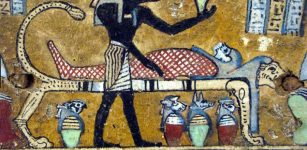 Unique Chinchorro Burial Tradition For All And Ancient Egyptians Who Mummified Kings And Nobles Only
Ancient Traditions And Customs | Nov 1, 2017
Unique Chinchorro Burial Tradition For All And Ancient Egyptians Who Mummified Kings And Nobles Only
Ancient Traditions And Customs | Nov 1, 2017
